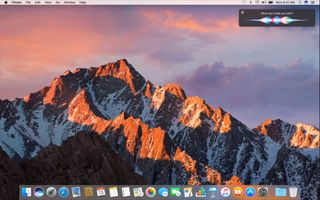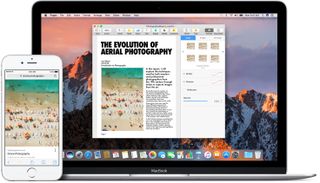
Apple's next iteration of Mac software is here, and we're so excited (we just can't hide it). While you wait for Sierra to download from the Mac App Store, check out our list of favorite features you have to look forward to.
Siri

When you install macOS Sierra, you'll have a keyboard-activated voice assistant at your fingertips: Yes, Siri is coming to the Mac — and with some valuable improvements from its iOS iteration.
It's multitasking time
When you are in the middle of a project, you don't have to stop what you are doing to perform tasks. If you are writing a report and remember that you are supposed to meet with your boss next week, you can get Siri's attention and tell the virtual assistant to create a calendar event, complete with date, time, and meeting attendees.
Turn Today view into widget central
You can pin Siri searches to your Mac's Notification Center, including such things as sports scores, Twitter feeds, and Reddit threads. Pins appear in the Today view alongside your current widgets, like the weather and your calendars.
Search contextually
When you ask Siri to search for something, you can follow it up with a secondary search query and the virtual assistant will remember your first request and apply it to the second one. For example, you can ask Siri to search for files you opened last week and then follow it up with, just the ones with "report" in the title.
Drag and drop your search results
When you search for something, Siri shows you the results in a pop-up window. You can drag and drop those results from Siri's window into other applications, or even your desktop. For example, you could ask Siri to show you pictures of Benedict Cumberbatch and then drag a picture into the Mail app to send to your mom when she asks who he is (I can even drag and drop into Photoshop again – a perfect fit for Ren's ridiculous workflow).
You can customize Siri
Similar to iOS, you have some customization options for Siri. You can turn off the virtual assistant altogether if you don't want it on your Mac. You can also change the voice and completely disable it, if you so choose. When you disable voice feedback, you can still use Siri, but you won't hear responses anymore.
Master your iPhone in minutes
iMore offers spot-on advice and guidance from our team of experts, with decades of Apple device experience to lean on. Learn more with iMore!
System

If it's system tweaks you want, macOS Sierra has a bevy of them.
You can use Apple Pay on the web
Apple is using the same Continuity structure as Auto Lock to make Apple Pay possible while on your Mac. When you are visiting a supported website and have something to purchase, you can click on the Pay with button and you will receive a notification on your iPhone or Apple Watch asking you to verify the purchase. This feature only works with Apple Watch and iOS devices with Touch ID.
iCloud Drive puts your Mac desktop on your iPhone
Apple has updated iCloud Drive to provide access to your entire Mac desktop on any device. So, all of those files, folders, and screenshots can be opened and used on your iPhone, iPad, or another Mac computer by opening a folder in iCloud Drive.
Universal clipboard can swap images
That's right. In macOS Sierra, you can copy a passage of text on your desktop and then switch over to your iPhone to paste it, and vice versa. But even better: As shown on the WWDC stage, you can even copy and paste images. That means you can create an image in an app like Procreate, then paste that image right inside an app like Pages or Photoshop.
You can spring clean your Mac and optimize its storage
Customizable storage preferences are coming to macOS Sierra in the form of Optimized Storage. This feature makes it possible for you to store older content in iCloud when your startup disc gets full. It also lets you delete items in your trash older than 30 days, remove duplicate files, clear caches, and get rid of redundant Mail data.
macOS Sierra, meet Swift 3
Developers can take advantage of the latest API tools with the latest version of Swift. There are also a few cool new features being added to the Metal framework.
Your Mac now supports Wide Color APIs
Apple has implemented system-wide graphics frameworks support for extended-range pixel formats and wide-gamut color spaces, making it easy to support devices with a wide color display.
Apps

Redesigned apps, improvements to existing apps, and app removal: Sierra's bringing a lot to the apps table.
Apple Music makes more sense
With iOS 10, Apple completely redesigned the UI of its music service, making it bigger, bolder, and much easier to understand. That interface will come to macOS Sierra, too: It won't be (sadly) in its own Music app, but it has been dramatically streamlined to reduce clutter and make finding information far less complicated than in prior versions.
Mark up your images
Markup, Apple's annotation plugin, expands from Mail to Photos, so you'll be able to add scribbles, callouts, text, signatures, and otherwise clarify — or vandalize — your images.
Goodbye, Game Center — at least in app form
Do you use Game Center on your Mac? If so, you'll be pleased to discover that you no longer have to sign in via a separate app when connecting your account; the Game Center app is no more. Instead, that information can be built directly into supported Mac games via to Apple's GameKit. (Lest you think your iPhone and iPad compatriots were being left out of this grand gaming revolution, the Game Center app is also being removed from iOS.)
Flash becomes a one-time, per-website option
For several releases now, Safari has shipped without Flash enabled — largely to save laptop battery life, maintain security, and to reduce the clutter of the user's browsing experience. Unfortunately, that meant that those who needed Flash (or plugins like Silverlight) for their jobs or video streaming often had to manually install the plugin or run Chrome.
In macOS Sierra, Safari aims to change all this: If you browse to a website happens to have Flash-only content, you'll be able to temporarily enable the plugin solely for that page. It will default back to disabled automatically when you venture to a different site, or when you close Safari. Better still, you'll be able to choose for Safari to regularly load plugins for certain websites, while keeping them disabled for the rest of the web. It's a better, safer browsing experience for you — without the hassle of needing a separate browser or manually enabling and disabling Flash.
Safari extensions — and content blockers! — are coming to the Mac App Store
Do you even use Safari extensions? You might, but didn't realize it: Extensions are browser widgets that sit in Safari's top bar. You can use extensions as the Pinterest Pin It widget, the Add to Amazon Wish List widget, and 1Password for the Web to add things to your Pinterest boards and Amazon wish lists, or fill in passwords — and now you'll be able to find them all in the Mac App Store.
Along with your typical Safari extensions, you'll be able to find one other category there: content blockers. Your favorite content blocking apps are going to be easier to find, download, and install because Apple will soon, as of Sierra, allow them into the Mac App Store.
iCloud supports non Mac App Store apps
iCloud is now available to apps both inside the Mac App Store and out, so you can have the convenience of Apple's online services no matter where you get your apps from. As long as your developer of choice has a registered Developer ID with Apple, that app should be able to take advantage of iCloud.
Your favorites?

We've got a ton of content coming on iMore about all things Sierra; in the meantime, let us know: What are your favorite hidden or small macOS Sierra features? Any we missed that you're excited about? Ping us in the comments!
Lory is a renaissance woman, writing news, reviews, and how-to guides for iMore. She also fancies herself a bit of a rock star in her town and spends too much time reading comic books. If she's not typing away at her keyboard, you can probably find her at Disneyland or watching Star Wars (or both).

The upcoming iPhone 16 Pro could finally fix an (in)famous Apple camera problem for good this time

Apple's iPhone shipments are on the decline, analysts warn, and you might be surprised who the big winners are

The Firefly generative AI was fed Midjourney images to help it learn — despite Adobe arguing it was a more ethical, safer alternative
Most Popular




